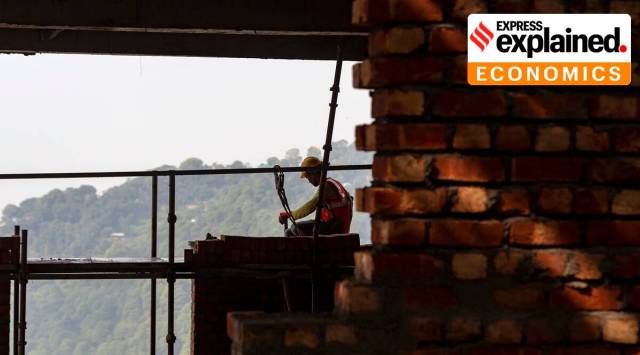Behind the conservative estimate for the next year are not just the many risks — global inflation to shortage of inputs — posed by Covid-19 the Survey points to, but also its assessment that the economic slowdown induced by the pandemic is not merely a demand problem.

But first, why is the 8-8.5 per cent growth estimate for the next year seen as modest? Last year, the Economic Survey (for 2020-21) had projected real GDP to grow 11 per cent in 2021-22, following estimates of a 6.6 per cent contraction in 2020-21. As things have turned out, the economy is estimated to grow only 9.2 per cent, as per the latest NSO estimate. Plus, the tapering off of the base effect also plays a part in the projections for next fiscal being more conservative.
The risks posed by the Covid-19 pandemic for the economic recovery flagged by the Survey arise from a surge in global inflation, shortage of inputs such as semiconductors, with supply-side disruptions being exacerbated by recovery in demand. While supply-chain breakdowns caused an interruption of the economy’s supply-side which also squeezed demand, the Survey notes it is not correct to see the pandemic related economic slowdown as just a demand problem. “…the post-Covid economy will not be merely a re-inflation of the pre-Covid economy. Simply building it back with demand measures is not a solution,” it said.
The growth projection for the next year is based on “the assumption that there will be no further debilitating pandemic related economic disruption, monsoon will be normal, withdrawal of global liquidity by major central banks will be broadly orderly and oil prices will be in the range of $70-$75/bbl.”
Newsletter | Click to get the day’s best explainers in your inbox
“The projection that the Economic Survey has made is on the conservative side compared to the projections that the other agencies have made. Growth naturally recovers from the fact that we had a 7 per cent contraction in real terms in 2020-21, the base effect continues… growth will be an instrument through which we tackle challenges. Economic growth picks up partly because credit growth is picking up from a very low base and the corporate sector has deleveraged and profitability is good. Therefore, we expect the capital expenditure cycle, which is now going to build on the back of what the government has done,” Chief Economic Adviser V Anantha Nageswaran said addressing reporters after the Survey was tabled in Parliament.

Story continues below this ad
The growth estimates for 2022-23 also ride on the widespread vaccine coverage, gains from supply-side reforms and easing of regulations, robust export growth, and the availability of fiscal space to ramp up capital spending. The latest Survey has made use of satellite and geospatial data to show the growth in national highway networks, spread of commercial banks, metro rail networks over the last decade and rise in construction in areas such as Golf Course Road in Gurugram, Bangmane Tech Park in Bengaluru and Bandra Kurla Complex in Mumbai over last 15-20 years.
Last year’s Survey had pitched for an expansionary fiscal policy in 2021-22 to boost growth and advised the government towards significant privatisation of state-owned companies, alongside an asset monetisation push and review of the banking sector asset quality. While the Budget that followed did flag the intent to pursue these measures, a number of those proposals are still work-in-progress.
The emphasis given to the supply-side in India’s Covid-19 response, the latest Survey noted, is driven by two reasons: first, Indian policymakers saw the disruptions caused by travel-restrictions, lockdowns and supply-chain breakdowns as an interruption of the economy’s supply-side. “Although this also squeezed demand, it is not correct to see the pandemic related economic slowdown as just a demand problem as happens with most economic cycles,” it said. Second, the post-Covid world will be impacted by a wide variety of factors – changes in technology, consumer behaviour, geo-politics, supply-chains, climate change, it added.
The Survey has flagged risks from rising inflation from both a tighter global liquidity condition and exchange rate volatility in global currency. “In 2021, inflation picked up globally as economic activity revived with the opening up of economies. Inflation in the US touched 6.8 per cent in November 2021, the highest since 1982, driven largely by energy and food prices. As inflation worries are mounting, a distinct shift towards the unwinding of pandemic-led stimulus is taking hold. This may result in tightening of financial conditions, adversely affecting capital flows, putting pressure on exchange rate and slowing down growth in emerging economies,” it said.
Story continues below this ad
Highlighting the divergence between wholesale and retail inflation, it said imported inflation is a problem and needs to be taken into account. India’s Consumer Price Index inflation stood at 5.6 per cent in December 2021 but wholesale price inflation, however, has been running in double-digits. “Although this is partly due to base effects that will even out, India does need to be wary of imported inflation, especially from elevated global energy prices,” it said.
The Survey also stated that the balance of risks for global trade is tilted to the downside, with the biggest risk from the pandemic, particularly with resurgence of new variants such as Omicron. In addition to the surge in global inflation, longer port delays, higher freight rates, shortage of shipping containers, shortage of inputs such as semiconductors, with supply-side disruptions being exacerbated by recovery in demand, pose significant risks, inter alia, for global trade.









































